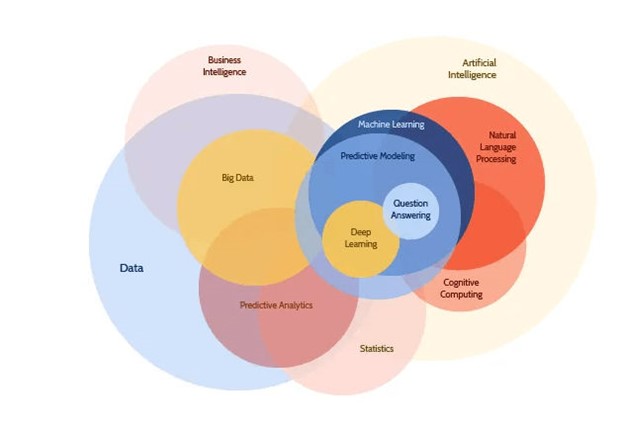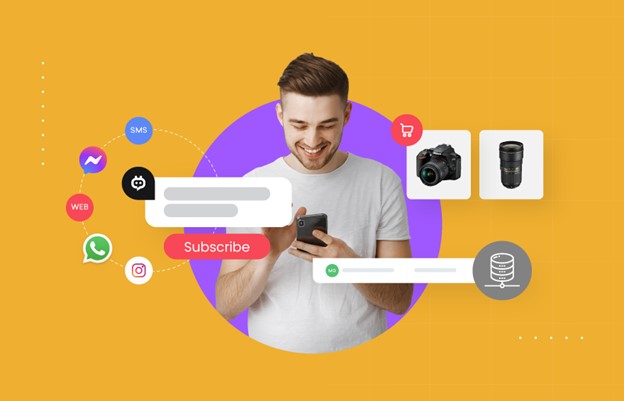17 min to read
I've been wanting to write for a long time, as it is part of our foundational name: Code + Design = Codedesign (where coding and technology meet marketing and solution design). This name was always a reference to us, but now, more than ever with AI and ML pushing code and solutions, it's more relevant than ever.
Combining marketing and coding in the rapidly changing digital era has become essential for success in the tech-driven economy. As businesses race to establish their digital footprint, the once distinct realms of coding and marketing find themselves converging in a dynamic intersection that promises innovation, efficiency, and unparalleled customer engagement. In this blog post, we will delve into the multifaceted relationship between coding and marketing, exploring how these seemingly disparate disciplines coexist and thrive when strategically connected.

The Power of Seamless Integration
In the realm of digital innovation, coding acts as the backbone, constructing the digital infrastructure upon which marketing strategies are erected. A seamless integration of coding and marketing ensures that the user experience is not only visually appealing but also technically robust. Websites, applications, and other digital platforms crafted by proficient coders lay the foundation for effective marketing campaigns. The aesthetics and functionality of a website, meticulously coded by skilled developers, serve as the canvas upon which marketing messages are artfully displayed.
The Art of User-Centric Design
One of the pivotal intersections between coding and marketing lies in the realm of user-centric design. Designers, armed with empathy and a keen understanding of their audience, craft interfaces that seamlessly guide users through a digital journey. The art lies not only in creating visually appealing layouts but in anticipating the user's needs, providing a harmonious blend of usability and aesthetics. It's a continuous process of refinement, driven by user feedback and evolving trends, ensuring that digital products not only meet the functional requirements but also forge a meaningful connection with the individuals who interact with them. In essence, the Art of User-Centric Design is a commitment to enhancing the human experience in the digital realm, making technology an intuitive and enjoyable extension of our daily lives.
The Role of Full Stack Coders and Handy Marketing Experts
Nowadays, the distinction between these two roles is blurred, giving rise to a new breed of professionals who seamlessly navigate both domains. In order to know why full stack coders and handy marketing experts are important, understanding their job is a must. Full stack coders, armed with a comprehensive skill set spanning front-end and back-end development, find themselves in a unique position to bridge the gap between coding intricacies and marketing strategies. Similarly, marketing experts armed with technical acumen become invaluable assets, translating marketing goals into technical realities. This convergence of skills ensures that digital initiatives are not only aesthetically pleasing but also technically proficient, marking the hallmark of a successful collaboration.

Data-Driven Decision Making
Data-driven decision-making has emerged as the cornerstone of strategic planning and operational excellence in the digital age. In a landscape inundated with vast amounts of information, businesses are increasingly relying on data analytics to glean actionable insights. This approach involves collecting, analyzing, and interpreting data to inform key business decisions. By leveraging data-driven decision-making, organizations can uncover patterns, trends, and correlations that might otherwise remain obscured. This methodology not only enhances the precision of decision-making processes but also mitigates the risks associated with uncertainty. In essence, data-driven decision-making transforms raw data into a strategic asset, empowering businesses to navigate complexities, optimize processes, and stay agile in an ever-evolving market.
Responsive Web Development and SEO Synergy
Responsive web development and SEO synergy form the backbone of a digital strategy that not only adapts to the diverse landscape of devices but also conquers the ever-evolving challenges of online visibility. Responsive web development, a coding practice that ensures websites dynamically adjust to various screen sizes, is indispensable in an era dominated by smartphones, tablets, and a myriad of browsing devices. This coding finesse not only enhances user experience but also aligns seamlessly with the algorithms that search engines employ to rank websites. The collaboration between coding experts and SEO strategists is particularly pronounced in ensuring that a website is not just technically robust but also ranks prominently in search engine results. This dual emphasis on technical adaptability and search visibility exemplifies the intricate dance between coding and marketing, where the synergy between responsive web development and SEO is pivotal in navigating the digital landscape successfully.
As we navigate the intricate tapestry of the coding-marketing intersection, it becomes evident that the synergy between these disciplines is not merely a trend but a fundamental shift in the digital landscape. Businesses that embrace this convergence with strategic intent find themselves not only at the forefront of technological innovation but also in tune with the ever-evolving needs of their target audience. The collaboration between full-stack coders and handy marketing experts, driven by data insights and a user-centric ethos, propels organizations towards a future where the lines between coding and marketing blur seamlessly, paving the way for unprecedented digital success.
Here are a few notes to include in your content strategy as well:
-
The landscape of content marketing is undergoing a profound transformation with the advent of AI-driven content creation and optimization. Artificial Intelligence, particularly in the form of machine learning and natural language processing, has enabled the automated generation of diverse content types, including articles, social media posts, and ad copies. This technology not only streamlines the content creation process but also ensures consistency in tone and style across various platforms. At Codedesign, we've leveraged AI tools to enhance our content strategy, creating high-quality, engaging content efficiently. This approach allows for scaling content production without compromising quality, a significant advantage in today's fast-paced digital marketing environment.
-
Machine learning algorithms play a pivotal role in optimizing content for different platforms, target audiences, and SEO purposes. These algorithms analyze large datasets to understand user preferences, engagement patterns, and search engine behaviors. This analysis informs content strategies, enabling the creation of tailored content that resonates with specific audience segments and performs well in search engine rankings. For example, Codedesign has utilized AI to fine-tune content for various social media platforms, ensuring that the message aligns with the unique user behaviors and preferences of each platform.
-
The potential of AI in content optimization is particularly evident in SEO. By analyzing search trends and keyword performance, AI tools can suggest content topics and keywords that are likely to attract traffic and engage readers. This capability is instrumental in developing a data-driven SEO strategy, a service that Codedesign offers to its clients. By integrating AI into our SEO practices, we ensure that the content not only appeals to the target audience but also adheres to the best practices of search engines, thus enhancing online visibility.
-
Real-world applications of AI-driven content creation and optimization have shown remarkable results in terms of engagement and conversion rates. For instance, a Codedesign client in the retail sector experienced a significant increase in online engagement and sales after implementing an AI-driven content strategy. The AI tools identified key trends and preferences among the client's target audience, leading to the creation of highly relevant and engaging content. This targeted approach resulted in improved website traffic, higher engagement rates, and an increase in conversions.
-
Another example from Codedesign's portfolio involves a client in the hospitality industry. By leveraging AI for content creation and optimization, the client saw a marked improvement in their social media engagement and direct bookings through their website. The AI-generated content was not only tailored to the interests and preferences of the target audience but also optimized for search engines, leading to higher visibility and more effective customer acquisition. These case studies underscore the transformative impact of AI in content marketing, proving its efficacy in enhancing engagement, boosting conversions, and driving business growth.
To learn more about how AI can revolutionize content marketing strategies, I recommend visiting these links from Codedesign:

Advanced Analytics and Predictive Modeling in Marketing
In the world of marketing, advanced analytics and predictive modeling have brought about changes revolutionizing how marketers understand and engage with their audiences. At the heart of this transformation lies coding – the element that enables the development of analytics platforms. These platforms excel at processing. Analyzing volumes of consumer data transforming raw information into valuable insights. Through efforts, between coders and data scientists, complex algorithms and data processing mechanisms are created. These systems analyze consumer behavior patterns, preferences and engagement metrics empowering marketers to make decisions based on data.
Predictive modeling a crucial aspect of analytics plays a role in predicting consumer behavior. By leveraging machine learning algorithms and statistical techniques predictive models can anticipate consumer actions by examining data. This foresight is invaluable, in optimizing marketing campaigns as it allows for refining strategies based on predicted customer responses. For instance predictive modeling can identify customer segments to respond to specific marketing messages or predict which products a customer is more likely to purchase next. As a result marketers can personalize their approach. Enhance the relevance of their communications.
One significant advantage of modeling is its ability to personalize customer experiences effectively. Understanding the behaviors and preferences of consumers allows businesses to customize their marketing strategies to better meet the specific needs of each customer. This level of personalization encompasses aspects, including targeted email campaigns and personalized product recommendations, on shopping platforms. By utilizing models that analyze real time customer data businesses can continuously update their recommendations and messages to align with the changing behaviors and preferences of consumers. This approach not enhances the customer experience but also contributes to increased engagement and loyalty.
There are real world examples that demonstrate how businesses have utilized analytics and predictive modeling. One notable instance is Netflix, which employs algorithms to suggest TV shows and movies based on users viewing history and personal preferences. This personalized approach has not improved user engagement. Has also played a crucial role in retaining subscribers. Another example is Amazon, whose recommendation engine analyzes customers purchase history browsing patterns and ratings in order to provide tailored product suggestions. This predictive modeling has significantly contributed to Amazons ability to successfully cross up sell products ultimately leading to substantial revenue growth.
In the sector predictive analytics has revolutionized companies like Target by leveraging customer data to anticipate life events such as pregnancies enabling them to tailor marketing campaigns accordingly. This strategy has resulted in increased customer loyalty, as higher spending levels.
These examples showcase the impact that advanced analytics and predictive modeling have on marketing. By helping businesses comprehend and foresee customer requirements these tools have become essential in the pursuit of gaining an edge and ensuring customer contentment, in the digital era.

Programmatic Advertising and Real-Time Bidding
Programmatic advertising represents a significant shift in the way ad space is bought and sold, with coding playing a pivotal role in its evolution. This form of advertising automates the decision-making process of media buying by utilizing software and algorithms, thereby replacing traditional methods which involved requests for proposals, tenders, quotes, and human negotiation. Codedesign, as a digital marketing agency, harnesses the power of programmatic advertising to deliver efficient and targeted campaigns for its clients. The automation enabled by coding allows for the purchasing of ad space in real-time, optimizing the advertising spend by targeting specific audiences at the right time and place. This method not only streamlines the ad buying process but also ensures that the ads are more relevant to the audience.
Real-Time Bidding (RTB) is a critical component of programmatic advertising. It's a process where advertising inventory is bought and sold on a per-impression basis, via instantaneous auction, similar to financial markets. This system utilizes sophisticated algorithms to evaluate and bid on each ad impression as it becomes available, based on criteria set by the advertiser (such as audience demographics, behavior, and location). RTB allows for incredibly precise targeting and optimization of ad campaigns in real time, greatly enhancing the efficiency and effectiveness of digital advertising efforts. Codedesign leverages RTB to optimize ad spend for its clients, ensuring that they get the best value for their advertising budget by targeting the most relevant audience.
The effectiveness and efficiency of programmatic advertising are underscored by its ability to reach target audiences with precision and at scale. According to recent industry reports, programmatic advertising is growing exponentially, with a significant portion of global digital advertising spend being attributed to programmatic methods. This growth is a testament to its effectiveness in engaging the right consumers at the right time, leading to higher conversion rates and better ROI for advertisers. Codedesign's experience with clients across various industries reflects this trend, with programmatic campaigns consistently outperforming traditional ad buying methods in terms of audience reach and engagement.
A case study from Codedesign's portfolio illustrates the power of programmatic advertising. One of our clients in the e-commerce sector saw a remarkable increase in both brand awareness and sales conversions after implementing a programmatic ad strategy. By leveraging data-driven insights and RTB, the campaign was able to dynamically adjust ad placements and bids in real time, targeting potential customers who were most likely to be interested in the client's products. This approach resulted in a significant increase in click-through rates and a substantial boost in ROI.
Another example involves a travel industry client who utilized programmatic advertising to reach a niche audience. Through precise targeting and real-time optimization of ad placements, the campaign achieved a higher engagement rate, with a noticeable decrease in cost per acquisition. This success story underscores the efficiency of programmatic advertising in reaching specific audiences, demonstrating its capability to deliver tailored messages that resonate with the intended demographic. These case studies highlight how Codedesign effectively employs programmatic advertising and RTB to drive success for its clients, showcasing the power of these technologies in the digital advertising landscape.

Chatbots and Conversational Marketing
The emergence of AI-powered chatbots has marked a significant evolution in the field of conversational marketing, customer service, and sales. These chatbots, enabled by advancements in artificial intelligence, are increasingly being used by businesses to engage with customers more effectively and personally. At Codedesign, we have observed a growing trend among our clients in adopting chatbots as a tool to enhance customer interaction, streamline service inquiries, and boost sales efforts. Chatbots are particularly effective in providing immediate responses to customer queries, facilitating smoother customer journeys, and maintaining engagement outside of standard business hours, thus improving overall customer experience and satisfaction.
The development of chatbots involves sophisticated coding, primarily centered around Natural Language Processing (NLP). NLP allows chatbots to understand and interpret human language, enabling them to respond in a way that is both contextually relevant and conversationally natural. This technology is crucial in making chatbots more human-like, allowing for more meaningful and efficient interactions with users. At Codedesign, we integrate NLP in our chatbot solutions to ensure that they can recognize customer intent and handle a wide range of queries with appropriate and helpful responses, thereby enhancing the overall effectiveness of the chatbots.
A key advantage of AI-powered chatbots is their ability to learn and adapt over time. With each interaction, chatbots can refine their understanding and improve their responses, thus becoming more effective in handling complex inquiries and customer needs. This continuous learning process, powered by machine learning algorithms, enables chatbots to offer increasingly personalized and relevant interactions, a feature that has been instrumental in the success of several Codedesign clients. Chatbots can identify patterns and preferences by analyzing past interactions, tailoring their responses to better suit individual customer profiles.
One notable example from Codedesign's is a retail client who integrated a chatbot into their online store. The chatbot was designed to assist customers in finding products, providing recommendations, and answering frequently asked questions. This implementation led to a marked increase in customer engagement and a higher conversion rate, as the chatbot was able to provide instant assistance, guiding customers through their purchasing journey efficiently. Furthermore, the chatbot was able to gather valuable insights from customer interactions, which were then used to optimize the client's marketing and sales strategies.
Another success story involves a hospitality client who utilized a chatbot to handle customer service inquiries and bookings. The chatbot, equipped with NLP capabilities, was able to handle a variety of customer requests, from room availability to local attractions, providing quick and accurate responses. This not only improved the efficiency of the client's customer service but also enhanced the overall guest experience, leading to higher customer satisfaction and repeat bookings. These examples highlight the effectiveness of AI-powered chatbots in transforming customer service and marketing strategies, showcasing their potential as a valuable tool for businesses looking to innovate their customer engagement approach.

AI is set to play an increasingly vital role at the intersection of coding and marketing. For businesses, AI technologies promise unprecedented efficiency in processing vast data sets, offering predictive insights for strategic decision-making. Machine learning algorithms are becoming integral in personalizing customer experiences, optimizing marketing campaigns, and even in creative processes like content creation. AI's ability to continuously learn and adapt will enable businesses to stay ahead in a rapidly changing digital landscape, making them more responsive to customer needs and market trends.
Conversational marketing, as a strategy, aims to offer personalized value to customers while enabling businesses to scale efficiently. It is about fostering genuine conversations and building real relationships, thereby enhancing the user experience and minimizing friction. This approach significantly diverges from traditional marketing techniques like TV commercials and newspaper ads, which often fail to engage modern customers. Instead, conversational marketing leverages tools like live chat, chatbots, and social media to facilitate meaningful, one-on-one interactions across various communication channels.
The benefits of conversational marketing include 24/7 availability through AI-powered bots, which customers appreciate for their immediacy and convenience. Additionally, these interactions provide a wealth of customer information, deepening the understanding of the audience and enabling more personalized messaging. This strategy also humanizes brands, making their outreach feel more natural and responsive compared to generic communication forms.
Sephora's Virtual Artist in Facebook Messenger is a prime example of this strategy in action. This AR feature allows customers to try on makeup virtually, enhancing their shopping experience and providing a practical, try-before-you-buy option. This innovative approach has led to an increased conversion rate for Sephora. Similarly, eBay's integration with Google Assistant for voice-activated searches demonstrates the power of conversational marketing in the e-commerce sector. This tool personalizes the shopping experience by understanding customer intent, thereby improving engagement and customer satisfaction.
Talk to Codedesign
Codedesign is a leading digital marketing agency renowned for its expertise in leveraging cutting-edge technologies and innovative strategies across various digital marketing domains. We specialize in advanced analytics and predictive modeling, using sophisticated coding techniques to process and analyze consumer data, enabling businesses to make informed, data-driven decisions. Our proficiency in AI-driven content creation and optimization allows us to deliver highly personalized and effective marketing campaigns. Additionally, our prowess in programmatic advertising and real-time bidding ensures maximum ROI for our clients through efficient and targeted ad placements. Furthermore, our expertise in integrating conversational marketing tools like AI-powered chatbots enhances customer engagement and service. By choosing Codedesign, businesses gain a partner adept in harnessing the power of digital technologies to achieve unparalleled marketing success. Contact us.
Incorporating these insights into Codedesign's approach, we recognize the value of conversational marketing in today's digital landscape. Our strategies focus on creating meaningful customer interactions, utilizing AI and machine learning to offer personalized experiences. By integrating technologies similar to Sephora's Virtual Artist or eBay's Google Assistant App, Codedesign aims to enhance client campaigns, increase engagement, and drive conversions. These examples illustrate how leveraging AI-driven conversational tools can transform marketing and customer service strategies, paving the way for more dynamic and successful business-customer interactions.
FAQs - Frequently Asked Questions
How does coding contribute to the success of digital marketing strategies?
Coding is the backbone of modern digital marketing strategies, offering a foundation upon which the edifice of digital campaigns is built. Its importance cannot be overstated as it enables the creation of tailored, dynamic user experiences that engage and convert. Coding facilitates the development of sophisticated websites, mobile apps, and other digital tools that are essential for implementing a broad range of marketing tactics, from email marketing to advanced SEO practices. Furthermore, coding allows for the seamless integration of analytics and tracking tools, enabling marketers to capture, analyze, and act on user data in real time. For example, Codedesign's implementation of bespoke algorithms and custom integrations for clients like Minor Hotels and L'Oréal has led to significant improvements in user engagement and conversion rates, underscoring the critical role of coding in digital marketing success.
In what ways does user-centric design impact marketing outcomes?
User-centric design is pivotal in determining the success of marketing outcomes as it prioritizes the needs, preferences, and behaviors of the target audience. By focusing on creating intuitive, accessible, and enjoyable digital experiences, businesses can significantly improve customer satisfaction, loyalty, and ultimately, conversions. A user-centric approach ensures that websites, apps, and other digital assets are designed with the end-user in mind, which enhances usability and engagement. For instance, a well-designed e-commerce platform that offers an easy navigation and checkout process can drastically reduce cart abandonment rates and increase sales. Moreover, user-centric design can boost a brand's reputation and differentiate it from competitors, as seen with Codedesign clients who have seen increased market share and customer retention through focusing on user experience.
What role do full stack coders and marketing experts play in integrating coding and marketing?
Full stack coders and marketing experts play a crucial role in bridging the gap between technical development and strategic marketing objectives. Full stack coders bring a comprehensive understanding of both front-end and back-end development, allowing them to implement complex marketing technologies, from CMS systems to personalized user experiences based on data insights. Marketing experts, on the other hand, provide the vision and strategic direction, identifying opportunities to leverage technology to meet business goals. Together, they ensure that digital tools and platforms are not only technically sound but also aligned with the marketing strategy to drive engagement, conversions, and loyalty. The collaboration between these two disciplines has enabled Codedesign clients to achieve remarkable results, including enhanced online visibility, streamlined customer journeys, and increased ROI.
How does data-driven decision-making influence marketing strategies?
Data-driven decision-making revolutionizes marketing strategies by grounding them in empirical evidence rather than intuition. This approach leverages data analytics to gain insights into consumer behavior, preferences, and trends, enabling marketers to tailor their strategies to meet the specific needs and interests of their target audience. By analyzing data from a variety of sources, including web analytics, social media engagement, and customer feedback, marketers can optimize campaign performance across channels, improve product offerings, and enhance customer experiences. For example, by employing advanced data analytics, Codedesign has helped clients like Altice and MartiDerm to identify high-performing marketing channels, refine targeting criteria, and predict customer behavior with greater accuracy, leading to more efficient allocation of marketing resources and higher conversion rates.
Can you explain the synergy between responsive web development and SEO?
Responsive web development and SEO share a symbiotic relationship that is critical for online visibility and user engagement. Responsive design ensures that a website provides an optimal viewing experience across a wide range of devices, including desktops, tablets, and smartphones, by adapting the layout to the viewing environment. This adaptability is crucial for SEO as search engines, particularly Google, prioritize mobile-friendly websites in their ranking algorithms. A responsive website not only improves user experience, leading to higher engagement and lower bounce rates, but also enhances SEO performance by consolidating your site's content under a single URL, which strengthens your search signal and improves your site's indexing. Codedesign's implementation of responsive design for clients has resulted in improved search rankings, increased organic traffic, and enhanced user satisfaction.
What are the benefits of AI and machine learning in content marketing?
AI and machine learning offer transformative benefits in content marketing, revolutionizing how content is created, personalized, and optimized. These technologies enable marketers to analyze vast amounts of data to identify trends, predict consumer behavior, and uncover insights that inform content strategy. AI-powered tools can generate content ideas, optimize headlines for engagement, and personalize content for individual users, increasing relevance and effectiveness. Additionally, machine learning algorithms can continuously analyze the performance of content across channels, refining content strategies in real time for maximum impact. For instance, Codedesign has leveraged AI to automate and personalize email marketing campaigns for clients like Pestana Hotel Group, leading to higher open rates, engagement, and conversion.
How does advanced analytics and predictive modeling transform marketing efforts?
Advanced analytics and predictive modeling transform marketing efforts by enabling businesses to anticipate market trends, understand customer behavior, and predict the outcomes of marketing strategies with a high degree of accuracy. These tools use historical data and statistical algorithms to identify patterns and predict future events, allowing marketers to make more informed decisions. By understanding which customer segments are most likely to convert, which marketing channels are most effective, and when consumers are most likely to make a purchase, businesses can allocate their resources more efficiently, customize their messaging, and optimize their marketing mix. Codedesign's use of predictive modeling for clients has led to improved targeting, increased ROI, and the ability to proactively adjust strategies in response to changing market conditions.
What is programmatic advertising and how does it benefit digital marketing?
Programmatic advertising is the automated buying and selling of online advertising space, using software and algorithms to purchase display space in real time. This technology allows advertisers to target specific audiences with unprecedented precision, based on a wide range of criteria including demographics, interests, behaviors, and more. The benefits of programmatic advertising to digital marketing are manifold. It increases efficiency and reduces costs by automating the ad buying process and eliminating the need for traditional negotiations and manual insertions. It also improves targeting and personalization, enhancing the relevance of ads to the audience and improving engagement rates. Codedesign's clients, such as FNAC and Uniplaces, have experienced increased campaign performance and efficiency through the use of programmatic advertising, highlighting its importance in a comprehensive digital marketing strategy.
How do chatbots and conversational marketing improve customer engagement?
Chatbots and conversational marketing significantly improve customer engagement by providing instant, personalized interactions at scale. These technologies leverage natural language processing to understand and respond to user queries in real-time, offering a convenient and efficient customer service solution. Chatbots can handle a wide range of tasks, from answering frequently asked questions to guiding users through the purchase process, improving the customer experience and freeing up human resources for more complex inquiries. Moreover, conversational marketing facilitates a two-way dialogue between brands and consumers, allowing for deeper engagement, feedback collection, and personalized recommendations. For example, Codedesign has implemented chatbot solutions for clients like Electrodomésticos Portugal, resulting in increased customer satisfaction, higher conversion rates, and improved loyalty.
In what ways can businesses leverage AI to enhance their digital marketing strategies?
Businesses can leverage AI to enhance their digital marketing strategies in numerous ways, from personalized customer experiences to optimized ad campaigns and content creation. AI technologies enable the analysis of large datasets to uncover insights about consumer behavior and preferences, which can inform targeted marketing strategies. Personalization engines powered by AI can deliver content and recommendations that are tailored to the individual user, significantly increasing engagement and conversion rates. In advertising, AI can optimize bidding strategies and ad placements in real time, ensuring that marketing budgets are used efficiently and effectively. Additionally, AI-driven content creation tools can help marketers produce content that is optimized for search engines and tailored to audience interests. Codedesign has effectively utilized AI across these areas for clients, enhancing campaign performance, customer engagement, and overall marketing efficiency.



Add comment ×